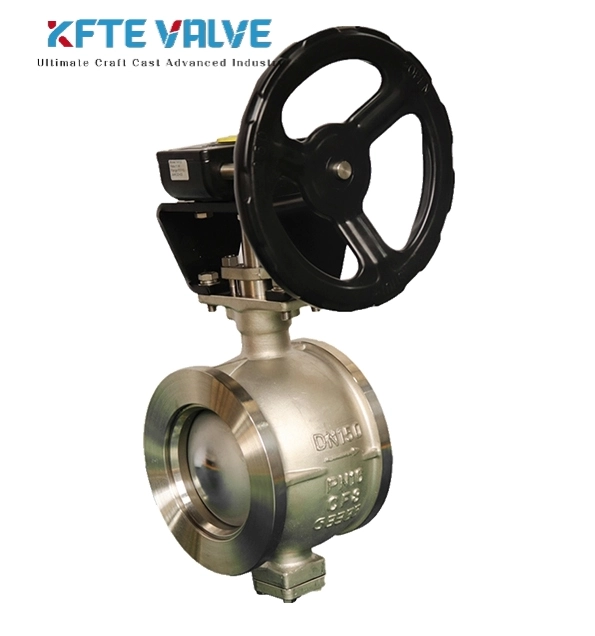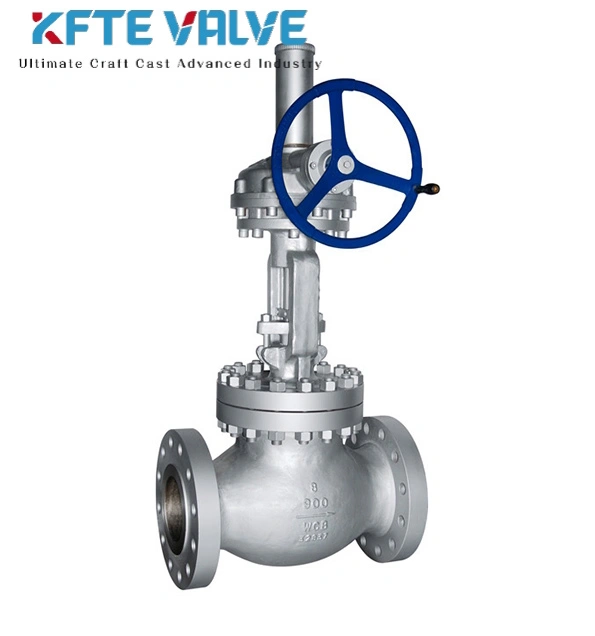Segmented ball valves are critical components in industrial fluid control systems, offering precision, durability, and versatility. At KFTE Valves, we specialize in high-performance segmented ball valves designed for demanding applications. This guide explores what segmented ball valves are, their applications, and how they compare to globe valves and V-notch ball valves, helping you choose the right valve for your needs.
A segmented ball valve is a quarter-turn control valve featuring a partially contoured ball segment with a V-shaped notch. Unlike standard ball valves, which are primarily for on/off control, segmented ball valves excel in throttling and precise flow regulation. The V-notch design allows for adjustable flow control, high capacity, and non-clogging performance, making it a hybrid between a ball valve and a globe valve.

The valve operates by rotating a hollow, spherical ball segment supported by a bearing and shaft. The drive shaft, connected to one side of the ball, rotates to expose the V-notch, adjusting the flow path. This quarter-turn mechanism (0-90°) enables:
Open/Close Control: Fully open for maximum flow or closed for shut-off.
Throttling: Partial rotation for precise flow modulation.
Self-Cleaning: The V-notch's sharp edges shear debris, preventing clogs.
High Flow Capacity: Large fluid volumes pass with minimal resistance.
Self-Cleaning Design: Sharp edges break down solids, ideal for slurries.
Excellent Throttling: Superior control compared to standard ball valves.
Durable Materials: Stainless steel, carbon steel, or coated alloys for corrosion resistance.
Compact Design: Quarter-turn rotary motion saves space compared to linear valves.
Shut-Off Capability: Tight sealing for zero leakage in closed position.
Segmented ball valves are widely used in industries requiring robust flow control for challenging fluids. Key applications include:
Pulp and Paper Industry: Managing high-viscosity pulp and slurries.
Chemical Processing: Controlling aggressive chemicals and thick fluids.
Wastewater Treatment: Handling suspended solids and sewage.
Oil and Gas: Regulating fuel, lubricants, and flammable media.
Pharmaceuticals: Precise flow control for production compounds.
Food and Beverage: Hygienic designs for easy cleaning and ingredient flow.
Power Generation: Controlling heating/cooling fluids in turbines.
Why Choose KFTE Segmented Ball Valves? Our valves are engineered for high-pressure, abrasive, and corrosive environments, ensuring long service life and minimal maintenance. Explore our range.
Globe valves are linear-motion valves known for precise flow control, but how do they compare to segmented ball valves? Below is a detailed comparison to guide your selection.

| Feature | Segmented Ball Valve | Globe Valve |
|---|---|---|
| Motion Type | Quarter-turn rotary | Linear (up/down) |
| Flow Control | Good throttling, high capacity | Excellent precision throttling |
| Fluid Resistance | Low (equal to pipe section) | High (requires more force) |
| Applications | Slurries, fibers, solids (e.g., pulp, wastewater) | Clean fluids (e.g., water, steam, oil) |
| Sealing Performance | Good, but less tight than globe | Superior, ideal for leak-tight shut-off |
| Installation Space | Compact | Larger due to linear actuator |
| Maintenance | Easy (movable sealing ring) | Complex (fixed components) |
| Cost | 35-50% less than globe valves | Higher due to complex design |
| Best For | High-viscosity, abrasive media | Precise flow in clean systems |
Fluid Resistance:
Segmented Ball Valve: Low resistance, similar to a straight pipe, reducing energy loss.
Globe Valve: High resistance due to tortuous flow path, requiring more actuator force.
Applications:
Segmented Ball Valve: Excels in handling fibrous or solid-laden media (e.g., pulp, sewage, chemicals).
Globe Valve: Suited for clean fluids like water, steam, or oil in systems needing precise regulation (e.g., cooling loops, fuel systems).
Structure:
Segmented Ball Valve: Rotary motion via a V-notch ball, compact and simple.
Globe Valve: Linear motion via a diaphragm or plug, more complex and bulky.
Cost and Maintenance:
Segmented Ball Valve: More cost-effective (35-50% cheaper) and easier to maintain due to movable sealing rings.
Globe Valve: Higher cost and maintenance complexity due to fixed components.
Sealing Performance:
Segmented Ball Valve: Reliable shut-off but less leak-tight than globe valves.
Globe Valve: Superior sealing, ideal for high-pressure or safety-critical applications.
Segmented Ball Valve: For cost-effective, compact solutions handling slurries, fibers, or high-viscosity fluids in industries like pulp, chemical, or wastewater.
Globe Valve: For precise flow control in clean fluid systems (e.g., cooling water, steam) where leak-tightness is critical.
Segmented ball valves and V-notch ball valves (also called V-port or V-ball valves) are both control valves with V-shaped designs, but their internal structures and performance differ. Below is a detailed comparison.
| Feature | Segmented Ball Valve | V-Notch Ball Valve |
|---|---|---|
| Ball Design | Contoured ball segment | V-shaped notch in ball/seat |
| Flow Control | Good throttling, high capacity | Precise, linear flow control |
| Self-Cleaning | Yes, sharp edges shear debris | No, prone to clogging |
| Fluid Resistance | Low | Higher due to V-notch |
| Applications | Slurries, high-viscosity fluids | Low-viscosity fluids, gases |
| Throttle Precision | Moderate | Excellent for fine-tuned control |
| Best For | Pulp, wastewater, chemicals | Pharmaceuticals, food, gas |
Design:
Segmented Ball Valve: Features a contoured ball segment with a V-notch, supported by dual shafts for robust operation.
V-Notch Ball Valve: Has a V-shaped notch in the ball or seat, designed for gradual flow adjustment.
Flow Control Precision:
Segmented Ball Valve: Offers good throttling but less precise than V-notch valves.
V-Notch Ball Valve: Provides linear flow characteristics, ideal for precise metering in low-viscosity applications.
Resistance to Clogging:
Segmented Ball Valve: Self-cleaning due to sharp edges that shear solids, perfect for slurries or fibrous media.
V-Notch Ball Valve: Less resistant to clogging, better for clean fluids or gases.
Fluid Resistance:
Segmented Ball Valve: Lower resistance, enhancing energy efficiency.
V-Notch Ball Valve: Higher resistance due to the V-notch’s restrictive flow path.
Applications:
Segmented Ball Valve: For applications involving slurries, thick fluids, or solids where self-cleaning and high capacity are priorities.
V-Notch Ball Valve: For precise flow modulation in clean, low-viscosity fluids or gas systems requiring linear control.
At KFTE Valves, our segmented ball valves are engineered for performance, durability, and cost-efficiency. Here’s why they stand out:
Customizable Designs: Wafer or flange-type valves tailored to your system.
Robust Materials: Stainless steel, carbon steel, or exotic alloys for harsh environments.
Precision Engineering: High throttling accuracy and tight shut-off.
Low Maintenance: Self-cleaning design and durable seals reduce downtime.
Competitive Pricing: Cost-effective solutions without compromising quality.
Case Study: A wastewater treatment plant in Zhejiang reduced maintenance costs by 40% and improved flow control by switching to KFTE segmented ball valves for slurry handling. Contact us to learn how we can optimize your operations.
Choosing between a segmented ball valve, globe valve, or V-notch ball valve depends on your specific requirements. Use this decision guide:
Fluid Type:
Slurries, fibers, or high-viscosity fluids? Choose a segmented ball valve.
Clean fluids or gases needing precise dosing? Opt for a V-notch ball valve.
Clean fluids requiring superior sealing? Select a globe valve.
Flow Control Needs:
Moderate throttling with high capacity? Segmented ball valve.
Fine-tuned linear control? V-notch ball valve.
High-precision throttling? Globe valve.
Budget and Space:
Cost-sensitive or space-constrained? Segmented ball valve (35-50% cheaper, compact).
Higher budget for precision? Globe or V-notch ball valve.
Maintenance:
Need low maintenance and self-cleaning? Segmented ball valve.
Can handle complex maintenance? Globe valve.
Q: What makes segmented ball valves different from standard ball valves?
A: Segmented ball valves have a V-notch segment for throttling and self-cleaning, unlike standard ball valves, which are primarily for on/off control.
Q: Can segmented ball valves handle high-pressure applications?
A: Yes, KFTE segmented ball valves are designed for high-pressure and abrasive media, with robust materials like stainless steel.
Q: Are segmented ball valves suitable for food processing?
A: Yes, their hygienic design and ease of cleaning make them ideal for food and beverage applications.
Segmented ball valves are versatile, cost-effective solutions for industries handling challenging fluids like slurries, chemicals, or pulp. Compared to globe valves, they offer lower cost, compact design, and better performance in fibrous media, though with slightly less precise throttling. Against V-notch ball valves, they excel in self-cleaning and high-viscosity applications but are less precise for low-viscosity fluids or gases.
At KFTE Valves, we provide high-quality segmented ball valves tailored to your needs, ensuring efficiency, durability, and cost savings. Ready to optimize your fluid control system? Request a quote or explore our segmented ball valve range today!